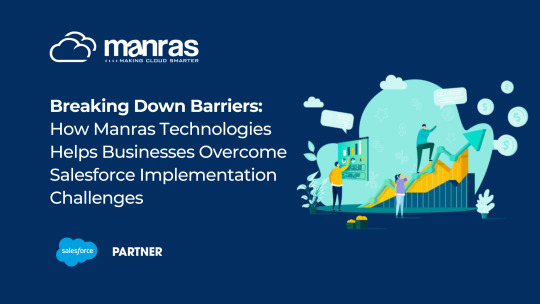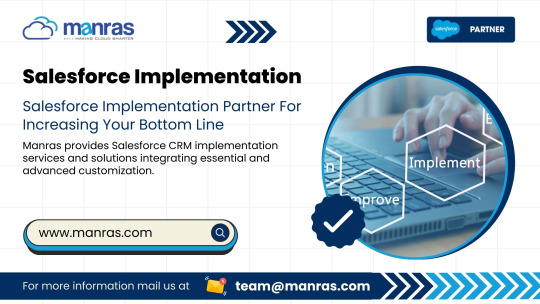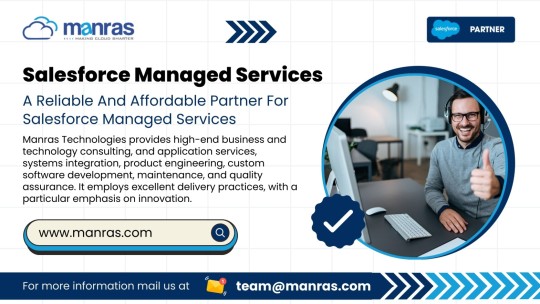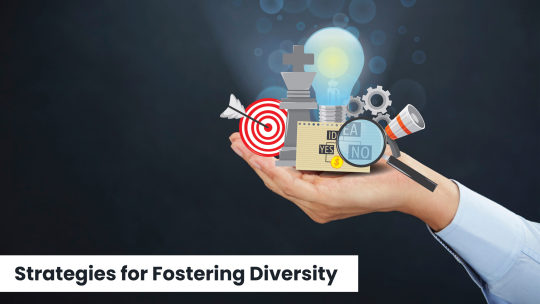#manras technologies
Explore tagged Tumblr posts
Text
Breaking Down Barriers: How Manras Technologies Helps Businesses Overcome Salesforce Implementation Challenges

Successful implementation of Salesforce brings major benefits enhancing the possibility of managing customer relationships, optimizing operation flow, and supporting growth. But, the process of getting to the essence of being a ‘Salesforce business’ is never exceptionless. There are always issues that crop up during the implementation process that hamper the progress of the implementation or result in costly mistakes. That is why Manras Technologies comes in—advising the businesses on how to overcome these and other issues and have Salesforce rolled out for its intended purpose.
Here’s how Manras Technologies helps break down the barriers to a smooth Salesforce implementation
1. Understanding Your Unique Needs
Arguably one of the biggest challenges facing the user when it comes to these implementation processes is the ability to match Salesforce to the company’s requirements. All the companies are unique, and that means that it needs to be tailored according to the specific company’s requirements. Manras Technologies has the time and duration to understand your business in and out. Based on the organization’s existing systems, processes, and objectives, our consultants optimize Salesforce accordingly. That way, when you get the product, it performs according to your specific needs from the word go and you don’t have to spend ages trying to tweak it to your needs.
2. Simplifying the Integration Process
Salesforce integration can get confusing and be a hassle when integrating it with the company’s current systems. Regardless of whether you require integration with an ERP, your marketing tools, or CS platforms, it gets rather complicated. To ensure an easier integration, Manras Technologies has the technical aspect solved. This is a turnkey operation where our experts guarantee that there is a harmonious connection between Salesforce and your existing systems making your business operations progressively better without the hassle.
3.Overcoming Data Migration Challenges
One of the greatest challenges that most organizations face during the implementation process is the transfer of data from old systems to Salesforce. Since data is the lifeblood of any business, all the relevant information must be migrated to Salesforce successfully without any loss or data distortion. Data migration is another area of specialty for Manras Technologies whereby the company utilizes other effective methods and techniques in shifting data with minimum risks and inconveniences. We also assist in sanitizing the data during the migration so that when you are done, you are starting afresh with clean data in Salesforce.
4. Continuous support and learning.
In any case, there can always be some issues even if Salesforce is already implemented, somebody may face some problems. Depending on your team, the solution may require scanning to get them familiar with the new system or if you have more users or larger folders or have updated your Salesforce instance. As for the support after initiating the work with Manras Technologies, it doesn’t stay indifferent. By offering constant support and presenting our expertise in the form of training we guarantee that your team will be comfortable working with Salesforce environment and efficiently utilizing the platform’s possibilities. From fixing breakdowns to teaching advanced skills, whether it is short or long term just let us know.
5. Provide for Expandability and Future Expansion
Remember that your business is not static and therefore your Salesforce too needs to grow and develop in response to current requirements. One difficulty lies in proving your setup can be adapted should it be needed as the business develops. When creating salesforce implementations, Manras Technologies considers expansion, which means that you will not outgrow the system. Our solutions are designed to be scalable so that changes are easily implemented when you introduce new products, enter new locations or acquire new employees.
Why Choose Manras Technologies?
Implementing Salesforce may indeed prove to be daunting, but this should not be a cause for alarm since it is quite far from being insurmountable. The company of Manras Technologies is in a position to assist businesses to overcome these issues and avoid any disruptions or complications with their Salesforce implementation. You get to work with our team to understand all your requirements, and ease of integration, and even have constant assistance from them. Having Manras by your side, there will be no challenges that cannot be addressed and you will be able to enjoy the full potential of Salesforce to promote your business. Are you prepared to tear down the walls of your Salesforce? Contact Manras Technologies today!
Know More: https://www.manras.com/salesforce-implementation/
0 notes
Text
How Salesforce Manufacturing Cloud Helps Predict Demand & Reduce Waste

Introduction
Manufacturing businesses are constantly seeking ways to improve efficiency, reduce waste, and better predict demand. Enter Salesforce Manufacturing Cloud—a specialized CRM solution designed to empower manufacturers with data-driven insights, AI-powered forecasting, and real-time analytics. Learn more about our Salesforce solutions. In this article, we will explore how this powerful tool helps businesses predict demand with precision and significantly reduce waste.
What is Salesforce Manufacturing Cloud?
Salesforce Manufacturing Cloud is a cloud-based solution tailored for manufacturing businesses to enhance visibility, improve collaboration, and optimize production. It brings together sales, operations, and finance teams, ensuring seamless communication and accurate forecasting. Unlike traditional CRMs, it focuses on demand planning, contract management, and real-time insights, allowing businesses to stay agile in a competitive market.
The Role of AI and Analytics in Demand Prediction
AI-powered analytics enable manufacturers to analyze historical sales data, market trends, and customer behavior to predict future demand. Read our in-depth guide on AI in demand forecasting. By leveraging machine learning algorithms, Salesforce Manufacturing Cloud helps businesses make data-driven decisions, reducing the risks associated with overproduction or underproduction. The predictive capabilities of this solution help businesses maintain optimal inventory levels and ensure production aligns with actual demand, minimizing financial losses and resource wastage.
Real-Time Data Integration
One of the key benefits of Salesforce Manufacturing Cloud is its ability to integrate real-time data from multiple sources, including ERP systems, IoT devices, and sales data. This seamless integration enables businesses to have a comprehensive view of their operations, leading to better decision-making. With real-time analytics, companies can quickly identify shifts in demand and adjust their production schedules accordingly, reducing inefficiencies and improving response times.
Collaboration Across Teams
The traditional disconnect between sales, finance, and production teams often results in inaccurate forecasts, supply chain disruptions, and wasted resources. Salesforce Manufacturing Cloud addresses this challenge by providing a unified platform where all stakeholders have access to the same data. This ensures that sales teams can align their commitments with production capacity, finance teams can budget accurately, and operations can optimize resource allocation efficiently.
Inventory Optimization and Waste Reduction
Overproduction and excess inventory are major concerns in manufacturing, leading to financial losses and increased waste. Predictive analytics in Salesforce Manufacturing Cloud helps manufacturers manage inventory effectively by ensuring production meets actual demand. Discover how predictive analytics can optimize inventory management. By reducing surplus inventory and aligning production with demand fluctuations, businesses can minimize material wastage and enhance sustainability efforts.
Enhancing Customer Relationships
When businesses can accurately predict demand, they can fulfill orders on time, reduce stockouts, and improve delivery timelines. This leads to better customer experiences and stronger long-term relationships. With Salesforce Manufacturing Cloud, manufacturers can proactively address potential issues before they arise, ensuring that customers receive their products as promised. Discover how improved demand forecasting enhances customer satisfaction.
Integration with Other Salesforce Products
Salesforce Manufacturing Cloud does not work in isolation—it seamlessly integrates with other Salesforce solutions such as Sales Cloud, Service Cloud, and IoT Cloud. This integration provides a holistic approach to customer management, production planning, and service support, ensuring a connected and efficient workflow. Learn how integrating Manufacturing Cloud with other Salesforce products enhances efficiency.
Challenges and Limitations
Despite its many advantages, implementing Salesforce Manufacturing Cloud comes with some challenges. Businesses may face data migration complexities, resistance to change, and integration issues with legacy systems. However, these obstacles can be mitigated with proper training, phased implementation strategies, and expert support from Salesforce consulting partners.
Sustainability and Environmental Impact
With growing concerns about sustainability, manufacturers are looking for ways to reduce their carbon footprint and minimize waste. Salesforce Manufacturing Cloud plays a crucial role in achieving these goals by optimizing resource utilization, reducing overproduction, and supporting eco-friendly manufacturing practices. Companies that adopt this technology can contribute to a greener future while also cutting costs.
Conclusion
Salesforce Manufacturing Cloud is a game-changer for manufacturers, offering data-driven demand forecasting, waste reduction, and enhanced collaboration. Businesses looking to stay competitive should leverage this powerful tool to optimize production, improve efficiency, and drive profitability. Contact us to learn how you can implement Salesforce Manufacturing Cloud.
0 notes
Text
0 notes
Text
Is Forex a Scam? Or Does Forex Investing Lead to Scams?
Forex trading is one of the largest financial markets, attracting millions of traders worldwide. While it offers profit opportunities, many people wonder if forex is a scam or if investing in it leads to fraudulent schemes. The truth is that forex itself is a legitimate market, but it is often exploited by fraudulent brokers and misleading investment schemes.
Forex: A Legitimate Market with Risks
Forex trading operates similarly to other financial markets, involving the exchange of currency pairs. However, its decentralized nature makes it a prime target for scammers who manipulate trades, deceive investors, and vanish with funds. Understanding these risks is crucial for anyone considering forex trading.
Common Forex Scams
Unregulated Brokers – Many scam brokers operate without proper regulation, making it easy to manipulate trades and restrict withdrawals.
Fake Investment Schemes – Some platforms promise guaranteed profits but function as Ponzi schemes.
Manipulated Trading Platforms – Fraudulent brokers create fake trading software that shows false profits, preventing withdrawals.
Signal and Account Management Scams – Scammers claim to offer expert trading advice but end up stealing funds.
High Withdrawal Fees and Hidden Charges – Some brokers impose excessive fees, making it nearly impossible to withdraw profits.
List of Known Scam Brokers
To help traders avoid scams, here are some brokers with a history of unethical practices:
Sterwa Holdings Review
Manra Capital Review
Premium Funds Management Ltd Review
Success Trade Partners Review
Sinarjaya Investment Review
PSI-Markets Review
HTFX Review
Clickafino Review
IE RATES Review
Cyber Capital Review
Smart Edge Financial Review
SNB Capital Review
Seneca Corporate Review
Deus Technology Review
Stonewall Capital Review
WilsonPartner Review
B-arclays.com Review
Ande Finance Review
SAFE INVEST Review
For Life Pro Review
Stratos Invest Review
Bright Securities Review
Elites Funding Review
How to Avoid Forex Scams
Choose Regulated Brokers – Verify licenses with authorities like FCA, ASIC, and CFTC.
Check Reviews – Read broker reviews from different review platforms.
Beware of Unrealistic Promises – No investment is risk-free.
Test Withdrawals – Before depositing large sums, confirm the withdrawal process.
Conclusion
Forex trading is not a scam, but fraudulent brokers and schemes make it risky. By trading with reputable brokers and staying informed, investors can minimize their risks and avoid falling victim to scams.
0 notes
Text
The Dark Side of Cryptocurrency: Scams and Fraudulent Brokers
Cryptocurrency has revolutionized the financial landscape, offering decentralized and borderless transactions. However, this innovation has also attracted malicious actors who exploit the technology’s complexities to defraud unsuspecting investors. Understanding common cryptocurrency scams and recognizing fraudulent brokers is essential for safeguarding your investments.
Common Cryptocurrency Scams
Ponzi Schemes: These involve enticing investors with promises of high returns with little to no risk. Returns are paid to earlier investors using the capital from newer investors, creating an illusion of a profitable enterprise until the scheme collapses. A notable example is OneCoin, which defrauded investors worldwide of approximately $4 billion.
Pump and Dump Schemes: Scammers artificially inflate the price of a cryptocurrency through false or misleading statements, only to sell off their holdings once the price is high, leaving other investors with devalued assets.
Phishing: This involves fraudulent attempts to obtain sensitive information such as private keys or login credentials by masquerading as a trustworthy entity in electronic communications.
Fake Initial Coin Offerings (ICOs): Scammers promote fraudulent ICOs to lure investors into investing in non-existent cryptocurrencies or projects, leading to significant financial losses.
Top 5 Fraudulent Brokers
Amanah Laju Review
Ahmed Prima Review
New Financial Technology Ltd Review
Manra Capital Review
Nortenway Review
Protective Measures Against Scams
Conduct Thorough Research: Before investing, research the cryptocurrency, the team behind it, and the project’s objectives. Be cautious of projects that lack transparency or have unverifiable claims.
Verify Regulatory Compliance: Ensure that the platform or broker is registered and complies with the regulatory requirements of your jurisdiction.
Be Skeptical of Unrealistic Promises: Be wary of platforms that promise guaranteed high returns with little to no risk, as these are often indicative of fraudulent schemes.
Use Secure Platforms: Opt for well-established and reputable cryptocurrency exchanges and wallets. Ensure they have robust security measures in place, such as two-factor authentication.
Stay Informed: Keep abreast of the latest news and updates in the cryptocurrency space. Regulatory bodies and financial news outlets often provide warnings about ongoing scams and fraudulent entities.
While the cryptocurrency landscape offers numerous opportunities, it is imperative to remain vigilant and informed to protect oneself from scams. By conducting due diligence and exercising caution, investors can navigate the crypto space more safely.
0 notes
Text

Hire Manras Technologies for top Salesforce staff augmentation services. Boost your team's capacity and performance effectively.
0 notes
Photo

Are you looking to implement a custom Salesforce solution to match your industry needs? Manras Technologies, is a Salesforce Platinum Partner having ample experience in the Salesforce domain and customizations. To know more visit us.
0 notes
Text
The Role of Artificial Intelligence in Sustainable IT

Introduction
In today’s rapidly evolving technological landscape, the importance of sustainability in IT cannot be overstated. With the growing environmental concerns, the IT sector faces increasing pressure to adopt sustainable practices. Artificial Intelligence (AI) emerges as a powerful tool with the potential to significantly impact sustainability efforts. This article aims to explore the crucial role AI plays in promoting sustainable IT practices, highlighting its applications in energy efficiency, resource management, predictive maintenance, green software development, and sustainable supply chain management.
Understanding Sustainable IT
Sustainable IT refers to the practice of designing, operating, and disposing of technology in ways that minimize environmental impact. This encompasses energy-efficient data centers, responsible e-waste management, and the use of renewable energy sources. The importance of sustainability in the IT sector is driven by the industry’s significant energy consumption and e-waste production. Achieving sustainable IT involves overcoming challenges such as high energy demands, rapid technological obsolescence, and the environmental costs of production and disposal. However, these challenges also present opportunities for innovation and the adoption of greener practices, with AI playing a pivotal role in this transformation.
AI and Energy Efficiency

Artificial Intelligence (AI) plays a crucial role in optimizing energy consumption in data centers, which are notorious for their high energy demands. AI-driven energy management systems can analyze vast amounts of data to predict and manage energy use more efficiently, reducing waste and costs. For example, AI algorithms can dynamically adjust cooling systems and optimize server workloads to ensure minimal energy usage. Companies like Google have successfully implemented AI to manage their data centers, achieving significant energy savings and reducing their carbon footprint. These AI-driven innovations highlight the potential for substantial improvements in energy efficiency within the IT sector.
AI in Resource Management
Artificial Intelligence (AI) enhances resource management by optimizing allocation and minimizing waste in IT operations. AI systems can predict resource needs, efficiently distributing computational power and storage to avoid over-provisioning. In smart grids, AI enhances electricity distribution by balancing supply and demand in real-time, reducing energy wastage. For example, AI algorithms can monitor and manage the usage of hardware and software resources, ensuring optimal performance with minimal environmental impact. Companies like IBM use AI to manage IT resources more sustainably, demonstrating AI’s potential to significantly improve resource efficiency and promote greener IT practices.
AI for Predictive Maintenance

Predictive maintenance, powered by Artificial Intelligence (AI), offers substantial sustainability benefits by predicting hardware failures and optimizing maintenance schedules. AI algorithms analyze data from sensors and system logs to identify patterns and anticipate issues before they lead to equipment breakdowns. This proactive approach extends the lifespan of IT equipment, reducing the need for replacements and minimizing electronic waste. For instance, AI-driven predictive maintenance systems in data centers can detect potential server failures early, allowing timely interventions. Companies like Microsoft utilize AI for predictive maintenance, ensuring efficient operation and contributing to sustainable IT practices by reducing resource consumption and waste.
Read More: https://www.manras.com/the-role-of-artificial-intelligence-in-sustainable-it/
0 notes
Text
Salesforce Implementation Partner For Increasing Your Bottom Line

Manras provides Salesforce CRM implementation services and solutions integrating essential and advanced customization.
We work specifically to help customers find the best solution to their problems and maximize their results while staying within their budget.
Our talented team of certified Salesforce implementation consultants, developers, and business analysts will work with you to determine your business needs operational challenges and develop a solution that fits your specific needs.
Read More: https://www.manras.com/salesforce-implementation/
0 notes
Text
Salesforce Managed Services

Manras Technologies provides high-end business and technology consulting, and application services, systems integration, product engineering, custom software development, maintenance, and quality assurance. It employs excellent delivery practices, with a particular emphasis on innovation.
Our Salesforce Managed Services provide a comprehensive solution that allows you to manage your Salesforce with the help of experts and experienced Salesforce administrators and consultants.
We provide the day-to-day support and services you need to ensure the success of your customer experience strategies which is more cost-effective than hiring full-time experts.
Read More: https://www.manras.com/salesforce-managed-services/
0 notes
Text
Top Features of Salesforce Elistein Analytics every Business Should Know

In today’s fast-paced, data-driven business world, advanced analytics help companies worldwide make better choices, provide better customer service and work more efficiently. This is where the high-tech Salesforce community tool Einstein Analytics really shines. Einstein Analytics helps companies use their data to find new ways to grow, improve, and develop new products. AI and ML are used. This piece talks about the best features of Salesforce Einstein Analytics that every business should use to be successful.
1. Predictive Analytics: Anticipating Future Trends and Behaviours
Salesforce Einstein Analytics’ most essential feature is predictive analytics, which predicts trends, customer behaviour, and company results. Using complex calculations and historical data, Einstein Analytics predicts market demand, client preferences, and corporate needs. Predictive analytics may help a store estimate seasonal sales, stock up, and personalize marketing. Businesses can maximize income by planning and matching resources and tactics with what and when customers are likely to buy based on prior data and outside influences. Financial projections, risk management, and workforce planning require predictive analytics. By identifying risks and opportunities early, businesses may reduce risks, seize new possibilities, and stay ahead in a changing market.
2. AI-Powered Insights and Recommendations: Enhancing Decision-Making
Salesforce Einstein Analytics uses AI and machine learning to provide insights and intelligent ideas to help employees make wise decisions. Einstein Analytics analyses data streams to uncover patterns, trends, and anomalies humans miss. It then offers practical advice for streamlining business operations. Einstein Analytics may use customer contacts, sentiment analysis, and problem resolution time to offer personalized strategies to make consumers happier in customer service. These AI-driven insights help service staff anticipate client needs, speed up work, and provide outstanding experiences that build customer loyalty. Einstein Analytics uses predictive analytics and customer segmentation to help sales and marketing teams locate high-value leads, prioritize sales opportunities, and create customer-specific marketing campaigns. Knowing customers’ behaviour and preferences helps businesses personalize interactions, increase conversion rates, and increase revenue
3. Interactive Data Visualization: Transforming Complex Data into Actionable Insights
Data visualization helps analyse complex datasets and disseminate insights throughout the firm. Salesforce Einstein Analytics’ powerful presentation features create interactive dashboards, charts, graphs, and maps from raw data. These visuals help anyone interpret data, detect trends, and understand real-time business performance. To assess sales performance, sales managers can utilize interactive dashboards to track pipeline velocity, conversion rates, and revenue forecasts. Customizable visualizations and drill-down capabilities help managers track sales trends, monitor team performance, and make data-driven decisions to improve sales tactics and accomplish goals. Data visualization is crucial for executive reporting, planning, and performance management. By clearly visualizing KPIs and operational measures, executives may assess an organization’s performance, identify areas for improvement, and ensure that strategic activities align with company goals.
4. Seamless Integration with Salesforce CRM: Unified Data and Enhanced Collaboration
Salesforce Einstein Analytics integrates effectively with Salesforce CRM. Companies may manage clients, sales processes, and operational data from one spot. Einstein Analytics uses CRM data to analyse real-time customer interactions, sales forecasts, and marketing campaign success. In Einstein Analytics dashboards, this interface lets sales teams track leads, opportunities, and customer contacts. Sales managers can more accurately and efficiently analyse sales performance measures, project revenue, and identify growth opportunities. Einstein Analytics improves marketing initiatives by analysing ROI, consumer engagement, and platform conversion rates. Integrated CRM data helps marketers track campaign performance, maximize marketing budgets, and optimize targeting tactics.
5. Mobile Accessibility and Real-Time Alerts: Empowering On-the-Go Decision-Making
In today’s mobile-first corporate world, real-time data and information are essential for swift decisions and responses. Salesforce Einstein Analytics’ native mobile apps let users browse dashboards, track data, and receive real-time alerts on their phones anywhere. A sales executive can receive push notifications on their phone when a high-priority opportunity progresses up the sales funnel or when client sentiment changes significantly. These real-time alerts allow CEOs to move quickly, collaborate well, and seize fresh opportunities without staying at their workstations. Mobile accessibility lets sales reps and service workers access customer data, service records, and performance indicators on the road, improving field sales and service operations. Mobile access to Einstein Analytics dashboards helps businesses run more smoothly, communicate with customers better, and get more done by remote staff.
Read More: https://www.manras.com/top-features-of-salesforce-elistein-analytics-every-business-should-know/
0 notes
Text
Building a Diverse Talent Pipeline: Recruitment Strategies for Inclusive Hiring

Introduction Building a diverse talent pipeline is essential for fostering innovation, improving performance, and ensuring long-term organizational success. Inclusive hiring practices not only reflect a commitment to equity but also attract a wide range of perspectives and skills. This article explores effective strategies for creating a diverse talent pipeline, highlighting the benefits of inclusivity in recruitment processes. By prioritizing diversity, companies can build stronger, more dynamic teams that drive growth and competitiveness in an increasingly diverse global market.
Understanding Diverse Talent Pipelines A diverse talent pipeline ensures a steady flow of candidates from varied backgrounds, fostering a more inclusive workplace. This pipeline is crucial for long-term organizational success as it brings diverse perspectives, enhances problem-solving, and drives innovation. Building such a pipeline involves proactive and strategic efforts to attract, develop, and retain diverse talent. It reflects a company’s commitment to diversity and inclusion, which can improve employee satisfaction, boost company reputation, and lead to better business outcomes. By investing in a diverse talent pipeline, organizations prepare themselves for a competitive and evolving market.
Strategies for Inclusive Hiring Creating a diverse talent pipeline requires strategic efforts in inclusive hiring. Key strategies include crafting inclusive job descriptions that appeal to diverse candidates and expanding sourcing channels to reach underrepresented groups. Implementing unbiased recruitment processes helps minimize unconscious bias, while leveraging technology can enhance inclusivity in hiring. Building relationships with diverse communities and educational institutions fosters a wider talent pool. Training recruiters and hiring managers on bias awareness and inclusive practices is essential. These strategies collectively ensure a more diverse, equitable hiring process, leading to stronger, more innovative teams.
Crafting Inclusive Job Descriptions Inclusive job descriptions are essential for attracting a diverse range of candidates. Use language that is welcoming and free from bias, avoiding gender-specific terms and industry jargon. Clearly outline the skills and qualifications required, focusing on essential criteria to prevent deterring potential applicants from underrepresented groups. Highlight the organization’s commitment to diversity and inclusion, and include information about inclusive policies and benefits. By crafting thoughtful and inclusive job descriptions, companies can reach a broader talent pool and encourage more diverse candidates to apply.
Expanding Sourcing Channels Expanding sourcing channels is crucial for reaching diverse candidates. Utilize diverse job boards, community organizations, and professional networks to broaden your reach. Partner with educational institutions that serve underrepresented groups and attend diversity-focused job fairs. Engage with social media platforms and online communities to connect with a wider audience. By diversifying your sourcing strategies, you can attract a broader talent pool and ensure that your hiring process is inclusive and representative of different backgrounds and perspectives. This approach helps build a robust and diverse talent pipeline.
Implementing Unbiased Recruitment Processes Implementing unbiased recruitment processes is essential for fostering diversity. Start by using structured interviews and standardized evaluation criteria to ensure fair assessment. Utilize blind recruitment techniques, such as removing identifying information from resumes, to reduce unconscious bias. Employ diverse hiring panels to bring varied perspectives to the selection process. Providing training on bias recognition and mitigation for recruiters and hiring managers is crucial. By systematically eliminating biases, organizations can create a more equitable hiring process, attracting a wider range of candidates and building a diverse talent pipeline.
Leveraging Technology for Inclusion Leveraging technology can significantly enhance inclusive hiring practices. Utilize AI-driven tools to screen resumes and match candidates based on skills, reducing human bias. Implement applicant tracking systems (ATS) that support diverse candidate searches and anonymized application processes. Use video interviewing platforms with features that promote fairness, such as structured interview guides and evaluation templates. Additionally, online assessment tools can objectively measure candidate abilities, ensuring equal opportunities. By integrating these technologies, organizations can create a more inclusive recruitment process, attracting a diverse talent pool and fostering a culture of equality.
Building Relationships with Diverse Communities Building relationships with diverse communities is crucial for creating a robust talent pipeline. Partner with organizations that support underrepresented groups, such as professional associations, non-profits, and community groups. Engage with educational institutions that have diverse student populations through internships, scholarships, and mentorship programs. Participate in community events and diversity-focused job fairs to connect with potential candidates. These relationships help establish a positive employer brand within diverse communities and provide access to a broader talent pool. By fostering these connections, organizations can attract and retain a diverse workforce, driving innovation and growth.
Training Recruiters and Hiring Managers Training recruiters and hiring managers on inclusive hiring practices is essential for building a diverse talent pipeline. Provide comprehensive training on recognizing and mitigating unconscious bias, focusing on equitable evaluation methods. Include modules on cultural competence and the benefits of diversity in the workplace. Regularly update training programs to reflect current best practices and emerging trends. Encouraging continuous learning ensures that recruitment teams are well-equipped to implement inclusive hiring strategies effectively. By investing in this training, organizations can create a more fair and unbiased recruitment process, attracting and retaining diverse talent.
Industry acceptance and actions Examining case studies and real-world examples highlights the effectiveness of inclusive hiring practices. Companies like Microsoft and Google have successfully implemented strategies such as inclusive job descriptions, diverse sourcing channels, and bias mitigation techniques. These organizations have seen significant improvements in workforce diversity and innovation. For instance, Microsoft’s Autism Hiring Program has demonstrated the benefits of focusing on neurodiverse talent. By showcasing these success stories, other businesses can gain insights and inspiration to adopt similar practices, fostering a more inclusive and dynamic work environment.
Read More: https://www.manras.com/building-a-diverse-talent-pipeline-recruitment-strategies-for-inclusive-hiring/
0 notes
Text
Inclusive Leadership Strategies for Fostering Diversity at Every Level

Introduction
Inclusive leadership is crucial in today’s dynamic business environment. By embracing diversity and fostering an inclusive culture, leaders can drive innovation, improve team performance, and enhance employee satisfaction. This article explores the importance of inclusive leadership and outlines effective strategies for promoting diversity at every level within an organization. Emphasizing the significant benefits of diversity, it sets the stage for understanding how inclusive leadership practices can create a more equitable and productive workplace.
Understanding Inclusive Leadership
Inclusive leadership is characterized by leaders who actively promote and value diversity. These leaders create an environment where all employees feel respected, valued, and able to contribute their best. Key traits of inclusive leaders include empathy, cultural intelligence, and a commitment to equity. Inclusive leadership plays a critical role in fostering a diverse workplace by encouraging different perspectives, facilitating open communication, and driving systemic changes that support inclusion. By embracing these qualities, leaders can cultivate a more dynamic, innovative, and productive organizational culture.

Strategies for Fostering Diversity
Implementing inclusive leadership involves several key strategies to ensure diversity is promoted at every organizational level. These strategies include creating an inclusive culture, developing unbiased hiring practices, offering training and development programs, establishing mentorship and sponsorship opportunities, fostering inclusive decision-making processes, and maintaining accountability through measurement and transparency. Each of these strategies plays a vital role in cultivating an environment where diverse perspectives are valued, and all employees feel empowered to contribute to their fullest potential.
Creating an Inclusive Culture
An inclusive culture is foundational for fostering diversity. It starts with establishing values and policies that prioritize inclusion and equity. Leaders must actively promote these values through their actions and decisions. Encouraging open communication and feedback is essential, ensuring that all voices are heard and respected. Inclusive cultures also celebrate differences and promote collaboration among diverse teams. By creating a supportive environment where everyone feels valued and empowered, organizations can harness the full potential of their diverse workforce, driving innovation and success.

Inclusive Hiring Practices
Inclusive hiring practices are essential for attracting and retaining diverse talent. Start by creating job postings that emphasize inclusivity and avoid biased language. Implement structured interviewing processes to reduce unconscious bias, ensuring that all candidates are evaluated fairly. Partner with diverse organizations and use diverse hiring panels to reach a wider talent pool. Providing training for hiring managers on recognizing and mitigating bias can further enhance the process. By prioritizing inclusivity from the start, organizations can build a more diverse workforce that drives innovation and reflects their commitment to diversity.
Read More: https://www.manras.com/inclusive-leadership-strategies-for-fostering-diversity-at-every-level/
0 notes
Text
Seamless Integration of Third-Party Data with Salesforce for Insurance Brokers

Salesforce integration with third-party applications involves connecting external software or services to the Salesforce platform. This process enhances the platform’s functionalities and allows businesses to address specific needs. By integrating third-party applications, businesses can centralize their data and create a single source of truth that improves accuracy and accessibility.
In this article, we will explore the challenges with insurance broker data management and discuss how Salesforce data integration insurance solutions, such as Mulesoft Anypoint, can help insurance brokers manage client and policy information.
What Are The Challenges With Integrating Different Data Sources?
Integrating data from various sources, like carrier systems and external databases, is crucial for insurance brokers. However, this process presents several challenges:
Data Format and Structure
Carrier systems and external databases often use different formats, such as spreadsheets or various file types, and organize their data uniquely. This requires converting and matching the data to ensure it works together smoothly. Without proper conversion, the systems may not understand or correctly interpret the data, leading to errors.
Data Quality
Inconsistent or inaccurate data can lead to errors and unreliable recommendations. For example, outdated or incorrect client information in one system can compromise the overall data quality. Cleaning and standardizing data is essential to ensure it is accurate and usable before integration.
Data Security and Privacy
Combining data from multiple sources increases the risk of security breaches and privacy issues. Sensitive client information must be protected from unauthorized access and potential threats. Compliance with regulations is crucial to avoid penalties and protect the company’s reputation.
Complexity and Cost
Data integration projects can be time-consuming and expensive, especially when dealing with large and diverse data sources. The process may require extensive planning, resource allocation, and specialized expertise, leading to increased operational costs.
Legacy Carrier Systems
Older carrier systems often present significant challenges for data integration. These systems may not have been designed with integration in mind, making data extraction difficult. In some cases, businesses may need to upgrade or replace outdated systems to facilitate effective data integration.
How does MuleSoft Anypoint help to create a unified data platform?
Here’s how Salesforce APIs and tools like MuleSoft Anypoint Platform connect Salesforce to carrier systems and help with third-party data for insurance brokers:
Connecting Systems and Applications
MuleSoft enables insurance brokers to integrate multiple systems and applications used across their operations. This integration eliminates the inefficiencies of manual data handling, known as “Swivel chair work,” where employees switch between systems to access and process information. By consolidating data into a unified platform, MuleSoft ensures brokers have a holistic view of client information, including policies, claims, and client interactions. Reusable APIs simplify data sharing between different departments, promoting collaboration and scalability within the organization.
Read More: https://www.manras.com/seamless-integration-of-third-party-data-with-salesforce-for-insurance-brokers/
0 notes
Text
Streamlining Client Onboarding with Salesforce in Insurance Broking

You would agree that the insurance industry deals with complicated processes. It faces the most cumbersome paperwork, tedious processes, and complicated rules & regulations. Client onboarding by insurance brokers is one such tedious task performed by insurers regularly. It is a perfect recipe to annoy your clients.
Being an insurer you need to complete the following tasks thoroughly to maintain an insurance policy:
Gathering and verifying client information
Completing paperwork, and
Ensuring compliance
If you perform these tasks using traditional methods, the effort needed can go up to unimaginable levels. However, using technology, you can ensure a smoother client onboarding. Salesforce CRM is a software that provides solutions to automate the client onboarding process. This AI-integrated software saves your time and effort while maintaining 100% accuracy.
In this blog, we discuss the challenges of traditional methods of client onboarding. We also discuss the need for Salesforce for insurance to overcome these challenges.
Challenges of Traditional Client Onboarding by Insurance Broker
If you continue using traditional methods for client onboarding by insurance brokers, you will face several challenges causing delays and prolonged processes. Here are the challenges of traditional onboarding methods:
Manual Data Entry
As an insurer, you need to record the following information about a client:
Personal Information of the clients
Their Financial details
Verification documents
If you use manual data entry, you have to create several records, registers, and files. It consumes a lot of time, effort, resources, and infrastructure costs. On top of that, it can lead to many errors.
Paperwork Overload
For onboarding a client, you have to maintain extensive documentation including forms, contracts, Stamps, KYC, and other compliance documents. Managing these documents physically requires a lot of infrastructure costs while causing environmental damage. The sheer amount of paperwork leads to inefficiency and misplaced documents.
Communication Gaps
Have you played Chinese Whispers? If yes, then you know the importance of clear communication in insurance broker onboarding. Unlike automated processes where information is used as it is, traditional methods like phone calls and emails rely heavily on the ability and coordination of the employees.
Compliance and Regulations
You have to follow many regulations for running an insurance business. Due to the high risk involved in insurance, regulations are important to safeguard the interests of all the parties. Using manual methods is not feasible to keep compliance documents for client onboarding in place and up-to-date.
Client Experience
The traditional client onboarding methods are complicated and cause delays. This can frustrate your clients and leave a poor first impression or lead to loss of business.
What is Salesforce Client Portal Insurance?
The Salesforce insurance client portal is a specialized feature within the Salesforce CRM tailor-made for the insurance industry. This portal acts as a dedicated online platform for insurance broker onboarding. It allows you to interact seamlessly with your clients making the process much smoother.
Read More: https://www.manras.com/streamlining-client-onboarding-with-salesforce-in-insurance-broking/
0 notes
Text
Harnessing the Power of AI: Salesforce Unveils New B2B Commerce Features

Salesforce, a leader in the IDC MarketScape for B2B Enterprise Commerce, has introduced five new Salesforce B2B commerce features. These features are not just new additions but powerful tools that can transform your business. They are designed to help businesses increase their revenue and operational efficiency, making it easier for them to thrive in the competitive market.
This article will explain the latest Salesforce updates, detailing each new feature and its benefits for your business. We’ll also discuss AI in B2B Commerce, showing how artificial intelligence can make business operations smoother and more effective.
What is Salesforce B2B Commerce Cloud? Salesforce B2B Commerce Cloud is a robust, cloud-based platform designed to help brands grow their online business by providing comprehensive tools and features that support every stage of digital commerce, from discovery to delivery. It enables brands to build and optimize e-commerce sites that boost conversion rates, unify the online and in-store shopping experience, engage customers on social media, and efficiently manage products and orders.
What Are The New Salesforce B2B Commerce Features? Now let’s explore the 5 new Salesforce B2B Commerce Features and discover how Artificial Intelligence integration is revolutionizing B2B sales:
Einstein Copilot for Buyers Einstein Copilot for Buyers is an AI-powered assistant introduced in Salesforce B2B Commerce Cloud. This tool transforms the buying process by allowing users to interact with the system using natural language or photos to identify products quickly. Buyers can easily add recommended items to their shopping carts and complete transactions without leaving the digital channel. Additionally, Einstein Copilot facilitates detailed conversations with businesses across various platforms, ensuring buyers receive personalized recommendations that match their needs and preferences. This level of interaction enhances the user experience and streamlines the purchasing process, making it more intuitive and efficient.
AI-Driven Goal Setting and Recommendations In Salesforce B2B Commerce Cloud, AI-driven goal setting and recommendations empower sellers to define and pursue their business objectives precisely. This feature leverages advanced AI algorithms to analyze data from Salesforce’s Data Cloud, providing sellers with real-time, actionable insights and customized recommendations. By integrating these AI capabilities directly into their daily operations, sellers can optimize their strategies, target their efforts more effectively, and achieve better outcomes. This proactive approach to business planning and execution helps sellers stay ahead in a competitive market by adapting quickly to changing conditions and customer needs.
Generative SEO Metadata Optimization Generative SEO Metadata Optimization in Salesforce B2B Commerce Cloud uses AI to enhance search engine optimization (SEO) for product listings. By harnessing Einstein’s SEO recommendations, sellers can automatically generate and fine-tune metadata, including product titles and descriptions. This optimized content is better positioned on search engine results pages (SERPs) and browser tabs, improving visibility and driving more organic traffic to the seller’s site. This feature addresses the often tedious and overlooked task of SEO maintenance, enabling sellers to boost their online presence and attract more potential customers without needing deep SEO expertise.
Enterprise Scale Carts and Split Shipments The introduction of Enterprise Scale Carts and Split Shipments caters to the needs of large-scale B2B operations. Enterprise Scale Carts allow for managing up to 2,000 line items in a single transaction, accommodating large volumes and complex configurations without performance degradation. Split Shipments enhance logistical flexibility by enabling different parts of an order to be shipped as soon as they become available, rather than waiting for the entire order to be ready. This capability is crucial for managing supply chain efficiencies and meeting customer expectations for prompt delivery, especially in critical time-sensitive distribution industries.
Native Merchant Settings The new Native Merchant Settings in Salesforce B2B Commerce Cloud simplify the integration and management of shipping, taxes, and checkout processes. These settings reduce complexity and potential compatibility issues by eliminating the need for third-party applications, leading to a smoother operation. Sellers can configure these elements directly within the platform, streamlining the setup and maintenance processes. This integration saves time and resources and enhances the reliability and security of transactions, providing a better experience for both sellers and their customers.
Conclusion In conclusion, AI in B2B commerce fundamentally changes how businesses operate, streamlining interactions and boosting efficiency in the digital world. The latest enhancements in Commerce Cloud demonstrate the significant benefits of AI-powered B2B commerce solutions, which simplify purchasing and enhance sales strategies with data-driven insights. As we continue to see how AI is revolutionizing B2B sales, it’s clear that these technologies are crucial for staying competitive. To fully leverage these innovations, partnering with experts like Manras, a certified Salesforce consultant, can help businesses unlock the full potential of their B2B commerce platforms. Contact Manras today to get started!
0 notes